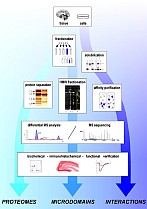Target characterization / identification of protein-protein interactions
Functional proteomic research has revealed that membrane proteins – as most other proteins – are associated with other proteins in so-called "supercomplexes" or "micro-domains". The composition of these complexes and the interactions among proteins determine important characteristics like cell type specificity, biological half life, cellular localization, specificity of function or the pharmacological profile. Thus, knowledge about physiological interaction partners is crucial for the effective selection and screening of pharmaceutical targets.Most approaches used for identification and characterization of protein-protein interactions are based on heterologous expression or in-vitro systems. They typically result in large datasets with a high fraction of false-positives and false-negatives. Since validation of candidates usually requires substantial time and resources, we set up a different strategy to obtain more reliable data from native source material close to physiology.
Biomarker research / target identification
Membrane proteins not only represent more than 60% of known drug targets but also have a high potential to serve as diagnostic or therapeutic markers. Despite their fundamental importance, this class of proteins is still underrepresented in proteome studies due to technological shortcomings and intrinsic challenges of hydrophobicity and low abundance. Furthermore, relevant sample sizes are too small (e.g. biopsies) for comprehensive studies. Finally, comparison of samples and protein levels requires reliable and unbiased quantification.
We have consequently optimized isolation and mass spectrometric sequencing of integral membrane proteins from native sources with highest sensitivity. With our label-free quantification method we are able to quantitatively analyse proteins from an unlimited number of samples - without loss in sensitivity or additional biases.
- native source material (tissue, cell line)
- systematic screening as well as targeted approaches
- applicable to all types of protein
- flexible combination of suitable techniques


